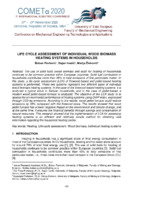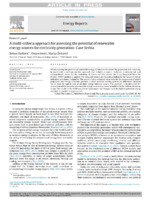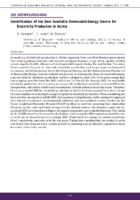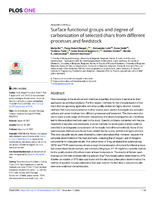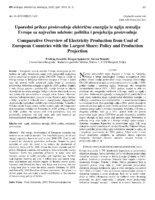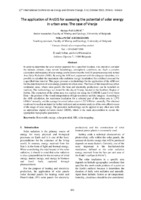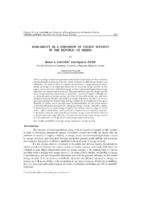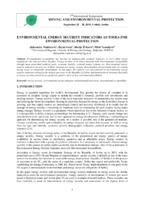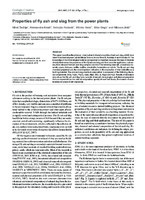Претрага
46 items
-
Long-term planning methodology for improving wood biomass utilization
The insufficiently developed forest management system is often followed by undeveloped forest resources supply chain and insufficient institutional support. These cause inefficient usage of fuel-wood as well as huge amounts of unused forest residues. In order to achieve optimal and long-term sustainable utilisation of biomass, an original methodology based on the interaction of mathematical optimization and backcasting approach has been developed. Mathematical optimization is used for both generation and consideration of techno-economic parameters of the forest biomass supply chain. ...Vladimir Vukašinović, Dušan Gordić, Marija Živković, Davor Koncalović, Dubravka Živković. "Long-term planning methodology for improving wood biomass utilization" in Energy, Elsevier BV (2019). https://doi.org/10.1016/j.energy.2019.03.105
-
Business Models for Small-scale Biomass Projects Development
Biomass is recognized as the most promising renewable energy source in Serbia. The share of biomass in Serbian final energy consumption is over 10%, but mostly related to traditional use in stoves and ovens. One of the main obstacles for wider implementation of contemporary biomass facilities is the inexperience of consumers and stakeholders in the implementation of “innovative” business models, especially in the cases of small-scale projects. In this paper, three different business models (public utility company, energy cooperative ...... Resources would be provided from cooperative fund. Cooperative would organize biomass collecting and woodchips production. Cooperative members and other forest owners in Kostojevići and surrounding settlements will provide biomass. In addition, cooperative would organize distribution and selling of heat ...
... sum for the new biomass DH plants adds up to 280,000 EUR (excl. VAT). The new biomass DH system amortizes dynamically within 10.5 years. The internal rate of return of the biomass DH system reaches 8.66%, and the net present value is 56,000 EUR. It was shown in [4] that a new biomass DH system is ec ...
... schoolyard. The biomass project is given in detail in [4 - 6] and it includes a fuel switch to biomass, i.e. wood chips. Based on an increased utilization of the existing DH grid by re-connection of former DH consumers and connection of new consumers, the installation of new biomass boilers instead of ...Dejan Ivezić, Miodrag Gluščević, Marija Živković. "Business Models for Small-scale Biomass Projects Development" in 19th International Conference on Thermal Science and Engineering of Serbia, Niš : Faculty of Mechanical Engineering (2019)
-
Life Cycle Assessment of Individual Wood Biomass Heating Systems in Households
The use of solid fuels (wood biomass and coal) for heating of households continues to be common practice within European countries. Solid fuel combustion in households contributes more than 46% to total emissions of fine particulate matter. In this study, a life-cycle assessment (LCA) of firewood-based and pellet-based heating systems is performed. These two systems represent two different types of individual wood biomass heating systems. In the case of the firewood-based heating systems, it is analyzed a typical stove ...... rs/g/vesti/file/Dokumenti/grejanje.pdf (accessed 10 Sept. 2020). [18] Forest Research (FR), Typical calorific values of fuels. https://www.forestresearch.gov.uk/tools-and-resources/biomass-energy- resources/reference-biomass/facts-figures/typical-calorific-values-of- fuels/.(accessed 20 Sept. 2020) ...
... pdf https://www.forestresearch.gov.uk/tools-and-resources/biomass-energy-resources/reference-biomass/facts-figures/typical-calorific-values-of-fuels/ https://www.forestresearch.gov.uk/tools-and-resources/biomass-energy-resources/reference-biomass/facts-figures/typical-calorific-values-of-fuels/ https://www ...
... ng-Wood-Biomass-for-Energy-Purposes-in-Serbia-FINAL.pdf http://biomasa.undp.org.rs/wp-content/uploads/2018/11/POSITION-PAPER-Status-of-Using-Wood-Biomass-for-Energy-Purposes-in-Serbia-FINAL.pdf http://biomasa.undp.org.rs/wp-content/uploads/2018/11/POSITION-PAPER-Status-of-Using-Wood-Biomass-for-Ener ...Boban Pavlović, Dejan Ivezić, Marija Živković. "Life Cycle Assessment of Individual Wood Biomass Heating Systems in Households" in 5th International Scientific Conference ”Conference on Mechanical Engineering Technologies and Applications” COMETa2020, East Sarajevo, 2020, University of East Sarajevo, Faculty of Mechanical Engineering East Sarajevo (2020)
-
A multi-criteria approach for assessing the potential of renewable energy sources for electricity generation: Case Serbia
When assessing the potential of renewable energy alternatives for electricity generation, it is necessary to implement a multi-perspective approach that includes economic, technical, environmental, and socio-political criteria. For the evaluation of criteria and alternatives, the Fuzzy Analytical Hierarchy Process (FAHP) method is applied. The obtained weights are formed according to the values of energy indicators and expert judgments. The use of a fuzzy numerical value scale for the assessment of expert judgments and energy indicators provides a more sensitive ...... soil if the basic condition in that area is met. • Biomass and biogas power plants — This includes power plants using biodegradable waste materials from agricul- tural production processes, forestry, and households, ma- nure from farms, products of forest management activi- ties, biodegradable residues ...
... potential of hydropower and biomass. Another fact, common for biomass and hydropower, is that electricity generation from biomass and hydropower provides more continuity in energy supply. The ar- gument for the highest priority of biomass is also in the fact that biomass fuels are typically used for ...
... current usage of RESs refers to the tradi- tional way of using biomass for heating and electricity generation by large hydropower plants (RS2, 2016). Biomass potential is estimated at 3.448 Mtoe. In the total potential of renewable energy, biomass participates with 61% (RS2, 2016). The largest part of hydro ...Boban Pavlović, Dejan Ivezić, Marija Živković. "A multi-criteria approach for assessing the potential of renewable energy sources for electricity generation: Case Serbia" in Energy Reports, Elsevier BV (2021). https://doi.org/10.1016/j.egyr.2021.02.072
-
Framework for biomass project selection at local level — the case study
Ivezić Dejan, Gluščević Miodrag, Ivić Milica. "Framework for biomass project selection at local level — the case study" in 4th International Symposium on Environmental Friendly Energies and Applications (EFEA), Beograd:IEEE (2016). https://doi.org/10.1109/EFEA.2016.7748801
-
Long-Term Planning Methodology for Improving Wood Biomass utilization
Vukašinović V., Gordić D., Živković Marija, Končalović D., Živković D.. "Long-Term Planning Methodology for Improving Wood Biomass utilization" in 3rd South East European conference on sustainable development of energy, water and environment systems (2018): 66
-
Identification of the Best Available Renewable Energy Source for Electricity Production in Serbia
Around 2/3 of electricity production in Serbia originates from coal-fired thermal power plants. The most significant domestic coal deposits are lignite deposits, a type of low -quality coal that causes negative health, climate and environmental impacts during the combustion. To reduce those negative impacts on domestic electricity production and to promote environmental awareness, the Serbian Energy Sector Development Strategy and the National Action Plan for Use of Renewable Energy Sources indicate the plan for increasing the share of ...Strategija obnovljive energije, Održiva energija, Proizvodnja električne energije, Solarna energija, Biomasa, Hidroenergije, Energija vetraBoban Pavlović, Dejan Ivezić, Marija Živković. "Identification of the Best Available Renewable Energy Source for Electricity Production in Serbia" in Conference on Sustainable Development of Energy, Water and Environment Systems, Sarajevo, 28.6.-2.7.2020., Faculty of Mechanical Engineering and Naval Architecture, Zagreb (2020)
-
Effects of Energy Production and Consumption on Air Pollution in Serbia
Marija Živković (2019)Energy production and combustion, mostly from unregulated or inefficient fuel combustion, are the single most important anthropogenic sources of air pollutant emissions. Energy sector in Serbia is highly fossil fuel intensive: 87.88% of energy consumed in Serbia is related to fossil fuels, while almost 95% of energy sources are combusted. In 2017. energy related carbon dioxide emission in Serbia is was 47.95 million tones. The main source of carbon dioxide emission was coal, responsible for almost 70% of energy ...... with a constant growth and the dominant share of fossil fuels of 79.7% 3. The renewable energy source with the highest share is biomass with 6%. Fossil fuels and biomass make more than 85% of the primary energy need to be transformed to heat and/or electricity through combustion processes 3, which are ...
... the country. Currently the transport sector is the main source of pollution in urban areas in Serbia, while the main sources of air pollution are: biomass (firewood) for carbon monoxide and NOx from the buildings sector and oil derivates for carbon monoxide and NOx from the transport sector. Key words: ...
... indicate that currently the transport sector is the main source of pollution in urban areas in Serbia, while the main sources of air pollution are: biomass (firewood) for carbon monoxide and NOx from the buildings sector and oil derivates for carbon monoxide and NOx from the transport sector. 4. DISCUSSION ...Marija Živković. "Effects of Energy Production and Consumption on Air Pollution in Serbia" in Mining and Environmental Protection-MEP 2019, University of Belgrade, Faculty of Mining and Geology (2019)
-
Surface functional groups and degree of carbonization of selected chars from different processes and feedstock
Marija Ilić, Franz-Hubert Haegel, Aleksandar Lolić, Zoran Nedić, Tomislav Tosti, Ivana Sredović Ignjatović, Andreas Linden, Nicolai D. Jablonowski, Heinrich Hartmann (2022)The knowledge ofthe structural and chemical properties of biochars is decisive for their application as technical products. For this reason, methods for the characterization of biochars that are generally applicable and allow quality control are highly desired. Several methods that have shown potential in other studies were used to investigate two activated carbons and seven biochars from different processes and feedstock. The chars were chosen to cover a wide range of chemical composition and structural properties as a hardness ...Biougalj, različiti procesi dobijanja, različite sirovine, površinski aktivne grupe, x-ray, FT-IR,XPS... the technical application of carbon black and activated car- bon has long tradition also including activated carbons from biomass [7], the large-scale car- bonization of biomass has found major interest in the last decade as a source for bioenergy [8], for the production of a valuable carbonaceous ...
... mere dehydration which is obviously the main process during the thermal decomposition of plant biomass. The intercept is 0.067 and represents the mean influence of the initial composition of the biomass and the changes due thermal degradation. Decarboxylation and decarbonylation result in lower ...
... Rasul M. G., Chowdhury A. A., Ashwath N., Biofuels production through biomass pyroly- sis-A technological review, Energies 2012, 5(12), 4952—5001. https://doi.org/10.9390/en5124952. Lewandowski WM, Ryms M, Kosakowski W. Thermal biomass conversion: A Review. Processes. 2020; 8: 516—560. hitps://doi.org/10 ...Marija Ilić, Franz-Hubert Haegel, Aleksandar Lolić, Zoran Nedić, Tomislav Tosti, Ivana Sredović Ignjatović, Andreas Linden, Nicolai D. Jablonowski, Heinrich Hartmann. "Surface functional groups and degree of carbonization of selected chars from different processes and feedstock" in PLOS ONE (2022). https://doi.org/10.1371/journal.pone.0277365
-
Towards more sustainable district heating systems in Serbia - Options and obstacles
The major share of energy consumed in the building environment is dedicated to meeting heating needs, which makes this sector one of the key players in the transformation of the whole energy system. The accurate approach to the transition process assumes acting on both the demand and supply sides. Lately, the supply side has received more attention, as its transformation is one of the key steps of the energy transition process. District heating systems are recognized as substantial contributors ...energetska tranzicija, daljinsko grejanje, dekarbonizacija, obnovljivi izvori energije, prepreke, SrbijaMarija Živković, Boban Pavlović, Dejan Ivezić, Miloš Tanasijević, Dejan Stojanović . "Towards more sustainable district heating systems in Serbia - Options and obstacles" in Conference on Sustainable Development of Energy, Water and Environmental Systems, Rome, September 8-12, 2024, Zagreb : Faculty of Mechanical Engineering and Naval Architecture (2024)
-
Geochemical characterization of sediments from the archaeological site Vinča – Belo Brdo, Serbia
Gorica Veselinović, Dragana Životić, Kristina Penezić, Milica Kašanin-Grubin, Nevenka Mijatović, Jovana Malbašić, Aleksandra Šajnović (2020)Gorica Veselinović, Dragana Životić, Kristina Penezić, Milica Kašanin-Grubin, Nevenka Mijatović, Jovana Malbašić, Aleksandra Šajnović. "Geochemical characterization of sediments from the archaeological site Vinča – Belo Brdo, Serbia" in CATENA, Elsevier BV (2020). https://doi.org/10.1016/j.catena.2020.104914
-
Possibilities for Reduction of Energy-Related Air Pollution in Serbia - Exploring Energy Scenarios
Fossil fuels and biomass account for almost 93% of the total primary energy supply in Serbia. Meeting the energy needs of consumers implies a transformation of the chemical energy of fuels through combustion processes to obtain heat that can be utilized as such, or further transformed into mechanical or electrical energy. These processes have an undeniable impact on air pollution, even in cases of biofuels or hydrogen combustion. Possibilities for air pollution reduction are identified, both on the supply ...Marija Živković, Boban Pavlović, Dejan Ivezić, Aleksandar Mijatović. "Possibilities for Reduction of Energy-Related Air Pollution in Serbia - Exploring Energy Scenarios" in 9th International Conference Mining and Environmental Protection, 24.-27. May 2023, Sokobanja, Serbia, Belgrade, Serbia : University of Belgrade, Faculty of Mining and Geology (2023)
-
Uporedni prikaz proizvodnje električne energije iz uglja zemalja Evrope sa najvećim udelom: politika i projekcija proizvodnje
Energetski razvoj zemalja Evrope decenijama je bio baziran na uglju. Instalisana snaga svih energetskih kapaciteta koji su zasnovani na uglju je preko 2000 GW. Ugalj je i dalje od bitnog značaja za dobijanje električne energije u Evropi. I pored toga što postoji veliki potencijal uglja, trend je smanjenja proizvodnje električne energije iz uglja do 2050. godine. Imajući u vidu Zelenu agendu i politiku EU, zemlje Evrope se okreću obnovljivim izvorima energije. Srbija u okviru obnovljvih izvora ima potencijala prevashodno ...Predrag Jovančić, Dragan Ignjatović, Stevan Đenadić. "Uporedni prikaz proizvodnje električne energije iz uglja zemalja Evrope sa najvećim udelom: politika i projekcija proizvodnje" in Energija, ekonomija, ekologija, Savez energetičara (2022). https://doi.org/10.46793/EEE22-3.63J
-
The application of ArcGIS for assessing the potential of solar energy in urban area: The case of Vranje
In order to determine the solar energy potential for a specified location, it is crucial to consider the latitude, altitude, slope, terrain morphology, atmospheric conditions, etc. Such a complex calculation and mapping of solar energy can be done using the ArcGIS geoprocessing tool, named Area Solar Radiation (ASR). By using the ASR tool, supported with the adequate input data, it is possible to calculate the maximum solar radiation energy (irradiation) for a defined area and for a specified time ...... solar radiation, it should in mind that solar radiation is also a precondition for the existence of wind energy, marine energy, and energy in biomass and · fossil fuels, · captured · through photosynthesis. For the purpose of heating and electricity production, the application of solar panels ...
... oil equivalent) per annum (Republic of Serbia, 2016). The largest part of the current usage of the RES refers to a traditional way of using biomass and large hydropower plant (Republic of Serbia, 2016). Other areas in reneWable energy, potentially with lower levels of environmental impact, ...
... potential can have a considerable contribution to the lesser utilization of fossil fuels, as well as the improvement of the environment. The biomass potential amounts to approximately 3.4 Mtoe per year (2.3 Mtoe per year is unused, and 1.1 Mtoe is used), 1.7 Mtoe lies in hydropotential (0.8 ...Boban Pavlović, Milica Pešić-Georgiadis. "The application of ArcGIS for assessing the potential of solar energy in urban area: The case of Vranje" in 12th International Conference on Energy and Climate Change, 9-11 October 2019, Athens - Greece, Energy Policy and Development Centre (KEPA) of the National and Kapodistrian University of Athens (2019)
-
Availability as a dimension of energy security in the Republic of Serbia
Boban Pavlović, Dejan Ivezić (2016)There is a range of modern approaches and models in literature for the evaluation and determination of energy security, which are based on different parameters and indicators. For most of them, a common characteristic is emphasizing the avail ability of energy, as an important dimension for ensuring energy security. In this paper, concise overview of Serbian energy sectors is given and appropriate energy indicators are defined and determined. Selected indicators provide insight into the main components that characterize availability ...... energy in Serbia is estimated at 5.65 Mtoe per year. Out of this potential, about 35% is already being used – mostly energy from hydro- power and biomass [15]. The RES1, as an indicator, refers the share of RES in TPES [9]: ( )1 Share of RES in TPESRES 0.15 15% TPES = = (12) Table 3 shows the share ...
... of energy in Serbia, and its energy security are indigenous energy production and use of fossil fuels, primarily coal, and renewables – hydro and biomass. Table 6. Results of individual significance of components Components of availability SOS SS D RES TM Criteria weight, wi 0.0475 0.4552 0.1423 ...
... efficiency in primary energy source use. The share of renewable energy in final consumption is currently around 20%. Hydro- power and traditional biomass (firewood) have the largest share in the renewable energy mix. The use of the other RES is still modest. If it is known that currently is being used ...Boban Pavlović, Dejan Ivezić. "Availability as a dimension of energy security in the Republic of Serbia" in Thermal Science, National Library of Serbia (2016). https://doi.org/10.2298/TSCI160923303P
-
Assessments of effects of implementation of strategic plans for development of Belgrade District heating system
The district heating system (DHS) is one of the key elements of the Belgrade energy system. Overview of the current state and basic characteristics of the DHS are presented in this paper. The focus is on the planned development of DHS and on the analyses of effects of realization of measures and projects defined by strategic documents related to DHS which are adopted by city authorities (Development Strategy of DHS and Strategy of Belgrade Development). Two exploratory scenarios were ...Dejan Ivezić, Marija Živković, Aleksandar Madžarević, Miodrag Grujić. "Assessments of effects of implementation of strategic plans for development of Belgrade District heating system" in Sustainable Cities and Society, Elsevier BV (2020). https://doi.org/10.1016/j.scs.2020.102304
-
Application of machine learning for diagnosing the operation of a deep well pump in oil production
Maja Trikić (2024)This paper will thoroughly examine how machine learning can improve the diagnosis of deep well pumps by analyzing the role and function of the pumps, dynamograms, sensor technologies, and diagnostic methods.Our analysis will provide insights into modern techniques and approaches for enhancing the performance and reliability of oil production systems, targeting cost reduction and increased operational efficiency.deep well pump, dynamograms, machine learning, diagnostics of operating coditions,Random Forest, XGBoost... tuning can help improve performance. 2. Random Forest: Random forest is an enhanced version of decision trees that uses multiple trees for decision-making. This algorithm reduces the risk of overfitting and improves classification accuracy. Random forest is effective in recognizing complex patterns ...
... Table 3 shows the organization of the tests into groups GroupA GroupB GroupC Group D ML algorithms Decision tree, Random forest and XGBoost AutoML Decision tree, Random forest and XGBoost Decision tree Number of instances per class 30 30 90 180 Test set size 50,098 50,098 50,098 50,098 Number ...
... reduction and increased operational efficiency. KEYWORDS:deep well pump, dynamograms,machine learning,diagnostics of operating coditions,Random Forest, XGBoost. CONTENTS 1. INTRODUCTION ... a aaaaaaeaa a aaa a aaaaaaaaaaakakaoi 1 2. ROLE AND FUNCTION OF DEEP WELL PUMPS IN OIL PRODUCTION.... ...Maja Trikić. Application of machine learning for diagnosing the operation of a deep well pump in oil production, 2024
-
Environmental Energy Security Indicators as Tools for Environmental Protection
Еколошка прихватљивост је постала незаменљив синтезни показатељ сваке валидне енергетске анализе у последње две-три деценије. Енергетска безбедност је у директној хармонији с еколошком прихватљивошћу кроз многе прописане политичке циљеве, економске користи, правне тековине итд. Индикатори еколошке сигурности представљају један од основних елемената за одређивање енергетске безбедности и снажне алате за усмеравање енергетског сектора ка одрживом развоју. У овом раду, анализа је била концентрисана на показатеље енергетске безбедности у области животне средине који се односе на сектор природног гаса у ...енергетска безбедност, еколошки енергетски индикатори, заштита животне средине, еколошка прихватљивост... sulfur oxides, but to a lesser extent than in the case of coal [16]. Combustion of biomass does not lead to the emission of sulfur oxide, because sulfur is not present, or only in the chemical composition of wood biomass. Natural gas is also characterized by no sulfur oxide emissions, unless the gas ...
... unit of energy produced for different energy products are given in Table 1. Table 1. The CO2 emission factors [13] Fuel Emission [kg CO2/GJ] Biomass 109.6 Peat 106 Stone coal 101.2 Brown coal 97.09 Lignite 96.43 Diesel 77.4 Crude oil 74.1 Kerosene 73.3 Gasoline 71.5 LPG 63.1 ...Aleksandar Madžarević, Dejan Ivezić, Marija Živković , Miloš Tansijević. "Environmental Energy Security Indicators as Tools for Environmental Protection" in Mining and Environmental Protection-MEP 2019, University of Belgrade, Faculty of Mining and Geology (2019)
-
State and perspective of individual household heating in Serbia: A survey-based study
This paper presents the results of the household survey on individual household heating systems in Serbia. The survey was conducted in the period October to December 2020 with the participation of 1100 households with individual household heating systems. The information collected in the questionnaire can be separated into three main parts: basic household data, current heating system characteristics, and households’ perceptions and attitudes. The survey results provide unique and comprehensive information concerning individual household heating systems and the main ...Boban Pavlović, Dejan Ivezić, Marija Živković. "State and perspective of individual household heating in Serbia: A survey-based study" in Energy and Buildings, Elsevier BV (2021). https://doi.org/10.1016/j.enbuild.2021.111128
-
Properties of fly ash and slag from the power plants
This paper describes the physical, chemical and mineral properties of ash and slag, which were taken from thermal power plants Nikola Tesla A, Nikola Tesla B, Kostolac A and Kostolac B. The knowledge of the mineralogical material composition is important because the type of minerals directly determines the properties of the fly ash and slag and their possible application. Laboratory tests showed that ash and slag samples consist of the following minerals: amorphous materials, quartz, feldspar, mullite, melilite, cristobalite, ...fly ash, slag, physical composition, chemical composition, mineral composition, X-ray diffraction method... application of biomass ash. Part 1. Phase-mineral and chemical composition and classification.– Fuel, 105, 40–76. VASSILEV, S., BAXTER, D. & VASSILEV, C. (2014): An overview of the behaviour of biomass during combustion: Part II. Ash fusion and ash formation mechanisms of biomass types.– Fuel, 117 ...Miloš Šešlija, Aleksandra Rosić, Nebojša Radović, Milinko Vasić, Mitar Đogo, Milovan Jotić. "Properties of fly ash and slag from the power plants" in Geologia Croatica, Zagreb : Croatian Geological Survey (2016). https://doi.org/10.4154/gc.2016.26


